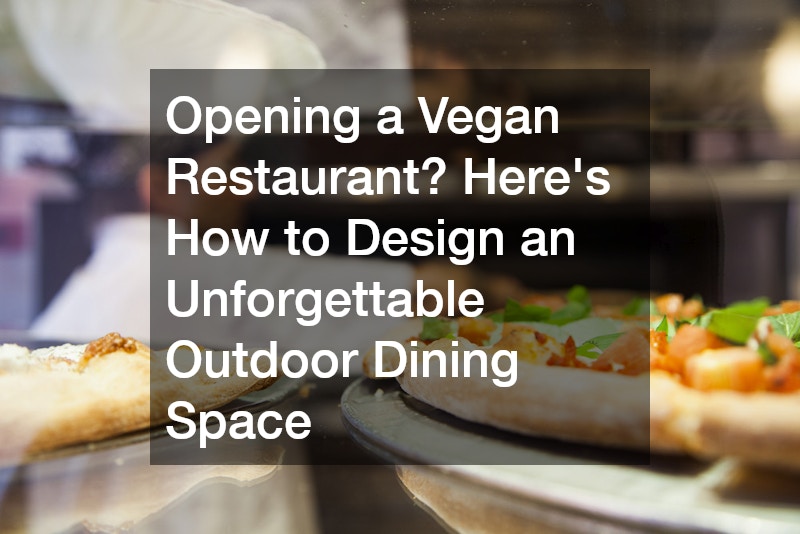Creating an unforgettable outdoor dining space is key to setting the tone when opening a vegan restaurant. Outdoor dining offers the perfect balance of fresh air, ambiance, and connection to nature, which aligns beautifully with vegan principles. This guide explores design tips, considerations, and strategies to help you create a space that not only attracts customers but also delivers a dining experience they won’t forget.

1. Embrace the Concept of Sustainable Design
Sustainability is often at the heart of veganism, and your outdoor dining space should reflect this value. Using eco-friendly materials, reducing waste, and integrating nature into your space will appeal to your environmentally conscious customers when opening a vegan restaurant.
Sustainable Materials Opt for reclaimed wood, recycled metals, and other sustainable building materials when constructing your outdoor dining area. Bamboo, a highly renewable resource, is another excellent option for furniture and design accents.
Low-Waste Operations Incorporating low-waste principles into the outdoor design will enhance your restaurant’s environmental footprint. Invest in durable, long-lasting furniture that won’t need frequent replacement. Compostable or reusable tableware and eco-friendly lighting options, like solar-powered lights, add to the sustainable charm.
Greenery and Nature Integration Adding plants, wildflowers, and even small garden areas can make the dining area feel like an extension of nature. Not only does this improve the aesthetics, but it also enhances the air quality and provides shade during sunny days. Professional landscaping contractors can assist with such projects.
2. Consider Climate and Location for Practicality
Designing an outdoor space means planning for various weather conditions. When selecting the location and layout of your vegan restaurant’s outdoor dining area, think about the climate and how best to accommodate it.
All-Weather Solutions If you’re in a region with extreme weather, offering protection from rain or heat is crucial. Pergolas, umbrellas, retractable awnings, and tents can help shield diners from the elements without sacrificing the open-air dining experience. A glass service can install windows for additional protection. For colder climates, outdoor heaters or fire pits are practical yet stylish options.
Seasonal Adjustments Keep in mind that your outdoor dining area may not be usable year-round unless you make provisions for different seasons. In warmer months, fans and misters can cool down the space. In cooler months, incorporate heaters, cozy blankets, or even seasonal décor to keep the ambiance alive.
3. Optimize Layout for Comfort and Flow
Your outdoor space should offer comfort without sacrificing efficient service flow. A great layout balances seating arrangements with pathways created by concrete companies for staff and diners to move comfortably when opening a vegan restaurant.
Seating Variety Offer a range of seating options to cater to different group sizes and preferences. Cozy two-tops for couples, long communal tables for larger parties, and casual lounge areas with couches or benches can give your customers the flexibility they desire. Comfortable seating with adequate spacing ensures diners won’t feel cramped.
Pathways and Flow Ensure your outdoor dining area’s layout is practical for both staff and diners. Clear pathways should allow servers to navigate efficiently, while diners should feel they can easily move around without disturbing others. Raised platforms or different sections within the space can help organize seating while adding dimension to the design.

4. Prioritize Lighting for Ambiance and Practicality
Lighting is one of the most critical elements in creating an unforgettable outdoor dining experience. Proper lighting enhances both the functionality and the mood of your space.
Ambient Lighting String lights, lanterns, and candles can create a warm, inviting atmosphere. These soft lights help set the tone for a relaxed dining experience. In eco-friendly fashion, consider using solar-powered lighting options, which are not only sustainable but also cost-effective in the long run.
Task Lighting While ambiance is essential, practical lighting is also a necessity. Ensure the space is well-lit so that diners can easily read the menu and enjoy their food. Lighting fixtures that are adjustable or dimmable can help transition the space from day to night without being too harsh or too dim.
5. Incorporate Nature-Centric Design
A vegan dinner restaurant thrives when it highlights the connection between food and nature. Use your outdoor dining space to strengthen this connection by incorporating nature-inspired design elements when opening a vegan restaurant.
Plant Walls and Vertical Gardens A plant commercial wallcovering, vertical gardens, and hanging planters create a green backdrop that complements the vegan dining experience. You can even grow some of the herbs or vegetables used in your dishes in these garden spaces, which adds a unique touch.
Water Features Incorporating a water feature, such as a fountain or small waterfall, can add to the tranquility of the space. The sound of flowing water creates a peaceful ambiance, encouraging diners to relax and savor their meal. Hire a commercial plumber to ensure the setup is perfect.
Natural Elements Stone walkways, wooden furniture, and organic fabrics all help ground the space in nature. These materials not only look stunning but also offer durability. Their neutral tones can serve as a backdrop for accent pieces like colorful cushions or vibrant plants.
6. Create an Immersive Dining Experience with Sensory Design
An unforgettable dining experience goes beyond taste—it’s about engaging all the senses. Think about how your outdoor dining space can stimulate the senses of smell, sound, and touch.
Fragrance Choose the best flowers for centerpieces as well as herbs to provide delightful fragrances that enhance the dining experience. Choose scents that complement the food, such as lavender, mint, or rosemary. Avoid overly strong smells that might overpower the aroma of the dishes.
Sound In addition to the natural sounds of water features, consider incorporating live music into your outdoor dining area. Acoustic, instrumental, or nature-inspired tunes can enhance the relaxing atmosphere without being intrusive.
Textures Make use of a variety of textures in your design to engage the sense of touch. From the smoothness of stone tabletops to the softness of fabric cushions and throws, these elements can make the space feel more comfortable and dynamic.

7. Leverage Branding Through Design Choices
Your outdoor dining area is a direct reflection of your restaurant’s brand. Every detail should communicate what your vegan restaurant stands for, from the colors you use to the overall vibe of the space.
Color Scheme When opening a vegan restaurant, choose a color palette that aligns with your restaurant’s identity. Earth tones often work well for vegan establishments, as they reflect nature and organic living. Green, brown, beige, and muted shades of yellow or blue can create a calming atmosphere.
Signage Make sure your branding is visible in your outdoor space without feeling over-commercialized. Subtle touches, like a wooden sign with your restaurant’s name or a custom mural, can reinforce your brand without overpowering the natural beauty of the space.
Custom Design Elements Custom features like unique lighting fixtures, personalized plant pots, or eco-friendly artwork can further distinguish your brand. These small touches help create an immersive brand experience for diners. Be sure to invest in commercial exterior cleaning services for a clean and sleek outdoor dining space, too.
8. Maximize Comfort with Thoughtful Amenities
In addition to aesthetic considerations, your outdoor space should offer amenities that enhance the diner’s comfort and convenience. The more comfortable people feel, the more likely they are to stay longer and return when opening a vegan restaurant.
Shade and Shelter Ensure there is adequate shade for sunny days and cover for rainy or windy weather. Retractable awnings or umbrellas offer flexible shelter options, while permanent structures like pergolas add style and functionality.
Heating and Cooling Options In many climates, heating and cooling options can make or break the outdoor dining experience. Invest in outdoor heaters, fire pits, or fans to ensure your space is comfortable in various weather conditions.
Comfortable Seating Comfortable, cushioned seating is a must. If your chairs are too hard or awkward, diners may leave before dessert. Consider ergonomic furniture or plush cushions to enhance the experience.
9. Focus on Accessibility and Inclusivity
Designing an outdoor dining space isn’t just about aesthetics and functionality—it’s about creating a space that is accessible and welcoming to all guests.
ADA Compliance Ensure that your outdoor space is accessible to people with disabilities by following ADA guidelines. This includes having ramps, accessible seating areas, and wide enough walkways for wheelchairs. Thoughtful design shows your commitment to inclusivity.
Dietary Considerations Vegan restaurants are often havens for those with dietary restrictions or food allergies. Ensure your outdoor dining space reflects that inclusivity with menus that clearly label allergens and staff trained to handle special requests.

10. Integrate Technology for a Seamless Dining Experience
As outdoor dining becomes more popular, technology can help enhance both the efficiency and the enjoyment of the space.
Mobile Ordering Offering mobile ordering through QR codes can streamline service and give customers the flexibility to order at their own pace. This can be particularly useful during busy times when traditional waitstaff might be stretched thin.
Wireless Speakers and Lighting When opening a vegan restaurant, bluetooth speakers and smart lighting can allow you to adjust the mood of your outdoor space with the touch of a button. These features make it easy to adapt the space for different occasions or times of day.
11. Offer an Eco-Friendly Menu That Reflects the Space
The menu is just as important as the design when creating an unforgettable dining experience. A plant-based, eco-conscious menu should align with the aesthetic of the outdoor space, making diners feel like they are participating in something meaningful.
Local and Seasonal Ingredients A key aspect of any successful vegan restaurant is offering locally sourced, seasonal ingredients. Not only does this reduce your carbon footprint, but it also allows you to create dishes that celebrate the flavors of the season.
Zero-Waste Options Minimizing food waste should be a priority when opening a vegan restaurant. Design your menu with smaller, shareable plates or offer half-portions to encourage diners to only order what they can eat. Composting leftover food is another way to show your commitment to sustainability.
Presentation and Aesthetics The beauty of the food should match the beauty of the outdoor space. Colorful, artfully plated dishes that feature fresh ingredients will excite your diners and encourage them to share their experience on social media.
12. Foster Community and Interaction
Your outdoor space should feel inviting, not just for individuals and small groups but for the larger community as well.
Community Tables Consider offering long, communal tables where strangers can dine together and build a sense of community. This is especially appealing to solo diners and fosters a welcoming, inclusive atmosphere.
Interactive Elements Incorporating interactive elements, such as a herb garden where diners can pick their own herbs or a communal chalkboard wall where they can leave messages, encourages engagement and makes the dining experience memorable.
13. Consider Sustainability Beyond the Design
Creating a sustainable outdoor dining space is just one part of opening a vegan restaurant. Extend your sustainability efforts to how you operate the space.
Energy-Efficient Practices Use solar panels to power your lighting or energy-efficient appliances in your outdoor kitchen space. This not only saves on operational costs but reinforces your brand’s commitment to the environment.
Water Conservation If you plan to incorporate a garden or water feature, consider water-saving techniques like drip irrigation or rainwater harvesting. This will help reduce your water usage while still maintaining a lush, green space.

14. Stay on Trend with Flexible Design
The restaurant industry is constantly evolving, and staying ahead of trends can help ensure that your outdoor dining space remains relevant.
Pop-Up Spaces Consider designing part of your outdoor area to function as a pop-up space for special events or collaborations with other local vegan chefs, artists, or musicians. These rotating experiences can keep your space fresh and exciting for regular customers.
Adaptable Seating Arrangements Flexible seating that can be easily rearranged allows you to adapt to different events or customer needs. Whether you’re hosting a small concert, a farmers’ market, or a simple outdoor brunch, flexible seating helps you maximize your space.
15. Market Your Unique Outdoor Dining Experience
Once your outdoor dining space is designed and ready, it’s time to promote it. Marketing your unique dining experience is essential for drawing in the crowd and creating buzz around your vegan restaurant.
Social Media Promotion Share high-quality photos of your outdoor dining space on social media platforms. Highlight the elements that make it special, such as eco-friendly design, beautiful natural scenery, or creative seating arrangements. Encourage diners to tag your restaurant and use a branded hashtag.
Events and Launches Host an official launch or a series of special events to introduce your outdoor dining space to the public. Offer a limited-time seasonal menu or discounted rates to attract first-time visitors and food bloggers.
Collaborations with Influencers Partner with local influencers, especially those in the vegan, food, or sustainable living space, to generate attention. Their followers can be a great source of new customers, especially when the ambiance and the food are both on point.
Designing an unforgettable outdoor dining space for your vegan restaurant is an opportunity to blend functionality with creativity while staying true to the principles of sustainability and connection to nature. Consider these tips when opening a vegan restaurant!



